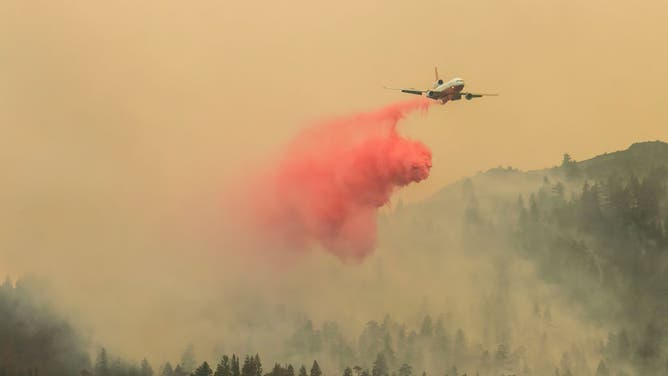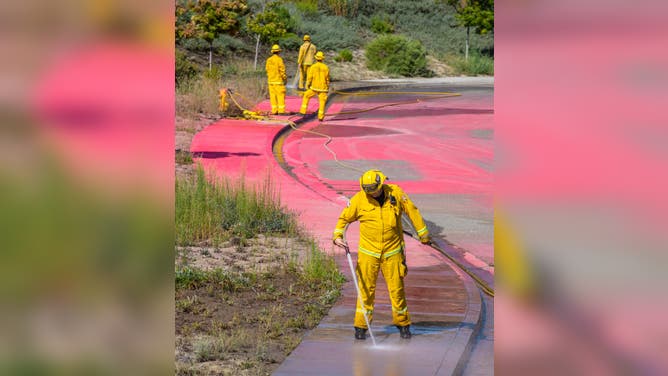7 things to know about fire retardant
Fire retardants are mostly used to fight fires in the western United States and rarely used in the Northeast, and only occasionally in the Midwest.

A DC-10 Air Tanker drops fire retardant over the Dixie fire.
(Ty O'Neil/SOPA Images/LightRocket via Getty Images)
You ever wondered what that red stuff is that's dropped from the sky when a wildfire breaks out? Well, it's fire retardant. Firefighters use it to help control and contain wildfires.
What’s in fire retardants?
Long-term retardants, mixed for delivery to wildfires, contain about 85% water, 10% fertilizer (all currently approved retardants use ammonium phosphate fertilizers), and 5% minor ingredients like colorant, corrosion inhibitors, thickener [natural gum and clay], stabilizers, and bactericides.
How does it work?
Colorants are added to make fire retardant visible so that pilots can see where earlier drops were made and accurately aim subsequent drops to help connect or reinforce retardant lines. This is important because if retardant lines aren't connected, wildfires can burn through the gaps.
The visibility of fire retardants is also important to help firefighters on the ground determine where to position themselves to construct a fireline.
Fire retardant contains salts that alter the way wildfires burn, decreasing fire intensity and slowing the advance of the fire, even after the water in the fire retardant has evaporated. The water in long-term fire retardants serves primarily to aid in the uniform dispersal of the chemical over the target area.
It’s usually not dropped directly onto flames; rather, firefighters anticipate where the fire might spread, and they drop the retardant ahead of the flames.
It also doesn't actually extinguish fires, but it does make it harder for trees and leaves to combust and buys firefighters time to clear out brush and vegetation that could cause a fire to spread. Long-term fire retardant is not meant to be applied to things that are already burning. Rather, it’s used to create a chemical fire break: once it's on vegetation, those plants won’t catch fire.
Environmental concerns
The United States Forest Service (USFS) says it should never be used within 300 feet of lakes, creeks, streams, or any body of water. According to USFS regulations, the high concentration of ammonia and phosphate will cause the waterway to become toxic, killing fish and aquatic life. It can also create algae blooms.
Minimal risks to humans
Fire retardant is generally safe — the Forest Service has said its risk of chemical toxicity is minor for most wild mammals, and it predicted no risk for people who are accidentally splashed. The nontoxic substance on human health is described as "minimal."
Some people have reported skin irritation, according to the USDA, but generally, the safety benefits of using the retardant outweigh those few incidents. While the substance is nontoxic, it shouldn’t be ingested by people or animals.
Things to do if you come into contact with fire retardant
- If Phos-Chek sticks to surfaces like a roof, wood, or sidewalk, a soft-bristle brush can be used to help speed its removal.
- To remove it from your skin, wash with gentle soap and water.
- After washing use a good quality hand cream to minimize drying and chapping.

Firefighters wash off the sidewalks, street and homes on Botanica Place in Murrieta that are covered in fire retardant on Friday, Sept. 6, 2019.
(Mark Rightmire/MediaNews Group/Orange County Register via Getty Images)
Things to avoid doing if you come into contact with fire retardant
- Do not use a high-pressure power washer, which can push the product deeper into surfaces like stone or concrete; if it gets deeply embedded, it may not come out.
- Do not leave Phos-Chek standing in puddles or pools, where pets or wildlife might drink it. After rainfall, be particularly vigilant, filling areas with sand, soil, or other absorbent material that can be removed if necessary.
Fire retardants mostly used in the Western United States
The USFS states that fire retardants are mostly used to fight fires in the western United States and rarely used in the Northeast, and only occasionally in the Midwest.